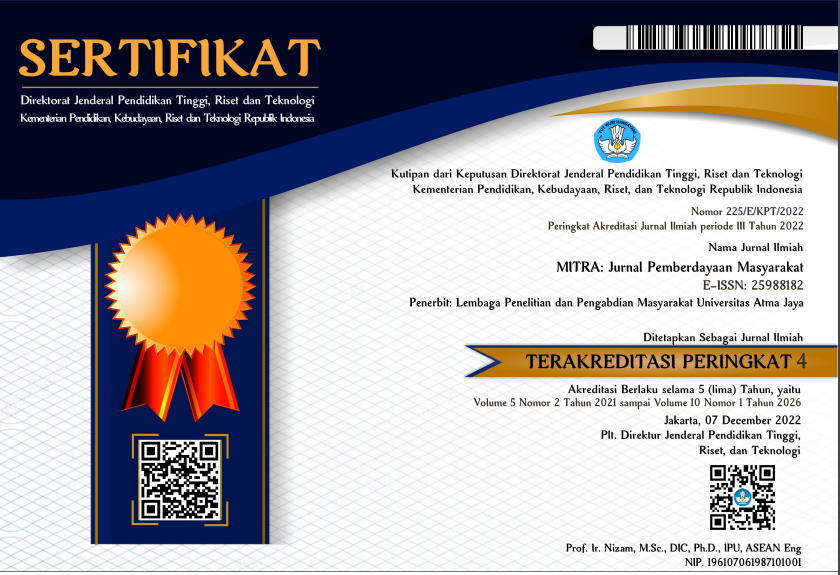Design of Portable Coffee Dryer in Kabawetan District, Kepahiang Regency
DOI:
https://doi.org/10.25170/mitra.v5i2.2213Kata Kunci:
portable architecture, Kabawetan, coffee, coffee dryer, designAbstrak
The statistical data of the Kepahiang Regency in 2018 shows that more than 90% of Kabawetan people worked in the agricultural sector as vegetable and coffee farmers. Due to the hilly morphology of the settlements, the settlement configurations should conform with the land contours. As the majority of the coffee farmers have limited land for drying the harvested coffee, portable architectural technology can then help overcome the problems with the limited house yard. This tool is used as a space for drying their coffee, especially during the rainy season. The method to transfer the portable coffee dryer design to the communities is by training them how to use the technology and introducing it with the help of props (prototypes). This introductory training was conducted for the Permata Sari farmer group in the farmer's house yard in Bukit Sari Village, Kabawetan District. The training activities included coordinating with the involved farmers, making coffee dryer designs, testing simple tools, and introducing the mobile coffee dryer technology to Permata Sari farmer group members in Bukit Sari Village, Kabawetan District Kepahiang Regency. Portable coffee dryers are urgently needed considering the contoured lands, limited space, and the frequency of rainy days in Kabawetan exceeds that of sunny days. However, this tool still requires further development, where it can be used as a sorting tool, particularly for sorting out the red pickled coffee that is dried using this tool.
Referensi
Arofik, S., Fitri, A. B., Nadhif, M., & Huda, A. (2018). Pendampingan peran dan potensi keagamaan, sosial dan ekonomi di Dusun Karangsemi Kecamatan Gondang Kabupaten Nganjuk. Janaka: Jurnal Pengabdian Masyarakat, 1(1), 68-79.
doi:https://doi.org/10.29062/janaka.v1i1.125.
Badan Pusat Statistik [BPS]. 2019. Statistik daerah Kepahyang 2019. Badan Pusat Statistik Provinsi Bengkulu.
Cooperrider, D., Whitney, D., & Stavros, J. (2008). Appreciative inquiry handbook: For leaders of change. 2nd Editions. Oakland, CA.: Berrett-Koehler Publishers.
Cooperrider, D.L. & Whitney D. (2001). A positive revolution in change: Appreciative inquiry. In Robert T. Golembiewski (ed.). The handbook of organizational behavior. Second edition. New York: Marcel Decker.
Lohmay, F., & Triyono, M. (2017). Keefektifan panduan pelatihan berbasis appreciative inquiry terhadap peningkatan kematangan karier siswa SMP. Jurnal Pendidikan: Teori, Penelitian, dan Pengembangan, 2(1), 65 - 72. http://journal.um.ac.id/index.php/jptpp/article/view/8440.
Prakash, T., & Satyanarayana, G. (2014). Performance analysis of solar drying system for guntur chili. International Journal of Latest Trends In Engineering and Technology (IJLTET),4(2), 283-298. doi:https://doi.org/10.21172/IJLET.v4i2.38.
Shalahuddin, A. A., & Yatmo, Y. A. (2008). Portable architecture: Keberadaannya terkait dengan ruang dan waktu. Universitas Indonesia, Departemen Arsitektur, Depok. Skripsi Departemen Arsitektur. http://www.lontar.ui.ac.id/detail?id=125401&lokasi=lokal.
Unduhan
Diterbitkan
Cara Mengutip
Terbitan
Bagian
Lisensi
This license allows reusers to distribute, remix, adapt, and build upon the material in any medium or format for noncommercial purposes only, and only so long as attribution is given to the creator. If you remix, adapt, or build upon the material, you must license the modified material under identical terms.







_.jpeg)




.png)
2.png)
.png)
.png)



